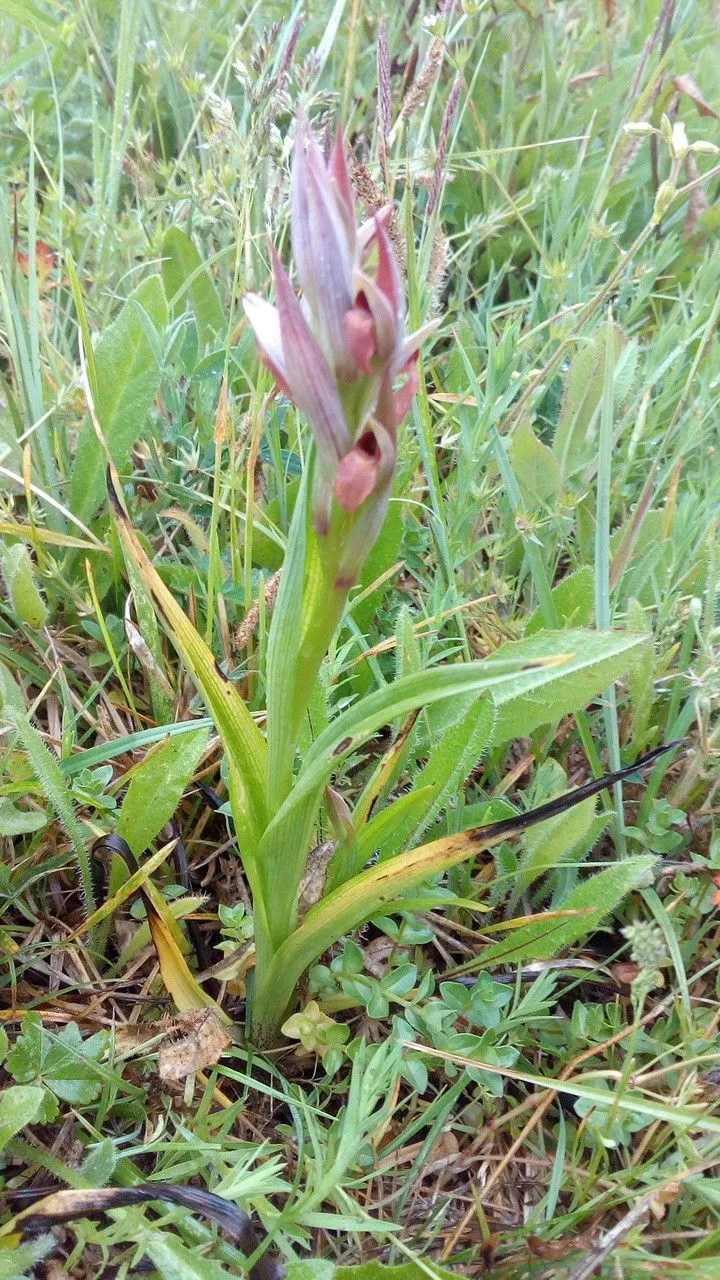
Author: Parl.
Bibliography: Giorn. Sci. Sicilia 59: 66 (1837)
Year: 1837
Status: accepted
Rank: species
Genus: Serapias
Vegetable: False
Observations: Azores (Santa Maria), Canary Is., Medit.
The Small-flowered Serapias, known scientifically as Serapias parviflora, is a captivating species belonging to the Orchidaceae family. Originally classified in 1837 by the distinguished botanist Parl., this orchid has captivated botanists and nature enthusiasts alike with its delicate beauty and ecological significance.
Primarily found in diverse regions, the Small-flowered Serapias thrives in the Azores, particularly on the island of Santa Maria, as well as in the Canary Islands and throughout the Mediterranean. Its distribution across these locales highlights its adaptability to varying climatic and environmental conditions.
The flower, true to its name, features small, yet striking blooms that capture the essence of subtle elegance. These blossoms contribute to the rich tapestry of flora in their habitats, playing a crucial role in local ecosystems. The intricate structure of the flowers not only appeals to human admirers but also to the specific pollinators that facilitate the plant’s reproduction.
The intriguing natural history and geographical spread of Serapias parviflora render it a subject of ongoing research and interest within botanical circles. Its presence in various islands and Mediterranean locales suggests it has evolved unique adaptations to thrive in these environments, making it an excellent specimen for studying plant adaptability and ecological interactions.
Overall, the Small-flowered Serapias is a botanical gem that underscores the rich biodiversity and intricate ecological webs of the regions it inhabits. Through continued study and conservation efforts, we can hope to preserve the delicate beauty and ecological importance of Serapias parviflora for future generations to appreciate.
Eng: small-flowered tongue-orchid
En: Small-flowered serapias, Small-flowered Tongue-orchid
Bg: Дребноцветен серапиас
Ca: Gallets, Gall parviflor
Nl: Kleine tongorchis
Fr: Serapias de flor pequeña, Séraplas à petites Fleurs, Sérapias à petites fleurs
De: Kleinblütiger Zungenstendel
It: Serapide minore, Serapide minor
Mt: Bajdet il-fenek
Pt: Serapião-de-língua-pequena
Ru: Серапиас мелкоцветковый
Es: Serapias de flor pequeña
Taken May 18, 2020 by Ramón Valle (cc-by-sa)
Taken May 7, 2019 by Llandrich anna (cc-by-sa)
Taken May 7, 2019 by Llandrich anna (cc-by-sa)
Taken May 7, 2019 by Llandrich anna (cc-by-sa)
Taken May 24, 2018 by Susana López (cc-by-sa)
Taken Apr 15, 1996 by Photoflora – Benoit BOCK (©)
Taken Apr 15, 1996 by Photoflora – Benoit BOCK (©)
Taken May 7, 2019 by Llandrich anna (cc-by-sa)
Taken Apr 25, 2017 by Tela Botanica − Florent BECK (cc-by-sa)
Taken Apr 25, 2017 by Tela Botanica − Florent BECK (cc-by-sa)
Taken Apr 25, 2017 by Tela Botanica − Florent BECK (cc-by-sa)
Taken May 4, 2016 by Tela Botanica − Florent BECK (cc-by-sa)
Taken May 4, 2016 by Tela Botanica − Florent BECK (cc-by-sa)
Taken Apr 15, 2007 by Photoflora – Yann QUELEN (©)
Taken Apr 15, 2014 by Photoflora – Benoit BOCK (©)
Taken Jan 1, 1970 by Photoflora – L’Abbé COSTE (©)
Taken Apr 15, 2014 by Photoflora – Benoit BOCK (©)
Taken Apr 23, 2018 by huy HO (cc-by-sa)
Taken Jun 9, 2019 by Daan Tijm (cc-by-sa)
Taken May 20, 2022 by Lisa Maunier (cc-by-sa)
Taken Jun 2, 2020 by Talarico Maurizio (cc-by-sa)
Taken May 7, 2016 by Daniele Boggiani (cc-by-sa)
Taken Apr 25, 2017 by Tela Botanica − Florent BECK (cc-by-sa)
Taken Jul 10, 2016 by Tela Botanica − Florent BECK (cc-by-sa)
Taken Jul 10, 2016 by Tela Botanica − Florent BECK (cc-by-sa)
Taken Jul 10, 2016 by Tela Botanica − Florent BECK (cc-by-sa)
Taken Jul 10, 2016 by Tela Botanica − Florent BECK (cc-by-sa)
Taken Jul 10, 2016 by Tela Botanica − Florent BECK (cc-by-sa)
© copyright of the Board of Trustees of the Royal Botanic Gardens, Kew.
Ph maximum: 5.0
Ph minimum: 4.5
Light: 8
Atmospheric humidity: 5
Bloom months: [‘mar’, ‘apr’, ‘may’, ‘jun’]
Soil nutriments: 2
Family: Myrtaceae Author: (F.Muell.) K.D.Hill & L.A.S.Johnson Bibliography: Telopea 6: 402 (1995) Year: 1995 Status:…
Family: Rubiaceae Author: Pierre ex A.Froehner Bibliography: Notizbl. Bot. Gart. Berlin-Dahlem 1: 237 (1897) Year:…
Family: Sapindaceae Author: Koidz. Bibliography: J. Coll. Sci. Imp. Univ. Tokyo 32(1): 38 (1911) Year:…
Family: Asteraceae Author: A.Gray Bibliography: Pacif. Railr. Rep.: 107 (1857) Year: 1857 Status: accepted Rank:…
Family: Fabaceae Author: Medik. Bibliography: Vorles. Churpfälz. Phys.-Ökon. Ges. 2: 398 (1787) Year: 1787 Status:…
Family: Aspleniaceae Author: (Cav.) Alston Bibliography: Bull. Misc. Inform. Kew 1932: 309 (1932) Year: 1932…